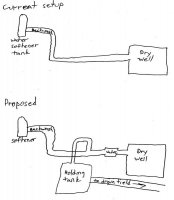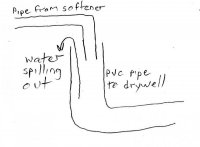Hi,
The short version is this: I'm looking for a valve that allows outflow from a water softener into a dry well, but will block a high water table from flowing back from the dry well.
The long version is this: I have a water filtration system (softener, acid neutralizer, and rust remover). They all regenerate and drain their backwash into a dry well. But when the water table is high, the backwash backs up into the house and spills onto the floor.
So my idea is to put a T in the pipe that goes to the dry well. Have that T go up, against gravity, and then feed into the septic system's holding tank which is just a few feet away (not into the septic tank itself). So backwash will normally go to the dry well, but when the water table is high and the dry well is full, the backwash will go up the T and flow into the holding tank, where it'll get pumped up to the drain field.
The one problem is that if the water table goes above the T, ground water will flow from the dry well into the holding tank and my pump will be trying to drain the entire yard. So I want a valve between the T and dry well. When the water table is low, backwash will be able to flow through the valve and into the dry well. When the water table is high, ground water will come into the dry well and flow back through the pipe, but the valve will be pushed closed and the ground water won't flow into the holding tank.
I've discussed this with my septic guy and he says it sounds good in theory but he has his doubts that it will work in practice. He can't really specify what he thinks will go wrong, but he's skeptical. And so I turn to the folks here.
Is there a valve on the market that would work here? Is there any reason to doubt it would work?
Thank you,
Bob
The short version is this: I'm looking for a valve that allows outflow from a water softener into a dry well, but will block a high water table from flowing back from the dry well.
The long version is this: I have a water filtration system (softener, acid neutralizer, and rust remover). They all regenerate and drain their backwash into a dry well. But when the water table is high, the backwash backs up into the house and spills onto the floor.
So my idea is to put a T in the pipe that goes to the dry well. Have that T go up, against gravity, and then feed into the septic system's holding tank which is just a few feet away (not into the septic tank itself). So backwash will normally go to the dry well, but when the water table is high and the dry well is full, the backwash will go up the T and flow into the holding tank, where it'll get pumped up to the drain field.
The one problem is that if the water table goes above the T, ground water will flow from the dry well into the holding tank and my pump will be trying to drain the entire yard. So I want a valve between the T and dry well. When the water table is low, backwash will be able to flow through the valve and into the dry well. When the water table is high, ground water will come into the dry well and flow back through the pipe, but the valve will be pushed closed and the ground water won't flow into the holding tank.
I've discussed this with my septic guy and he says it sounds good in theory but he has his doubts that it will work in practice. He can't really specify what he thinks will go wrong, but he's skeptical. And so I turn to the folks here.
Is there a valve on the market that would work here? Is there any reason to doubt it would work?
Thank you,
Bob



